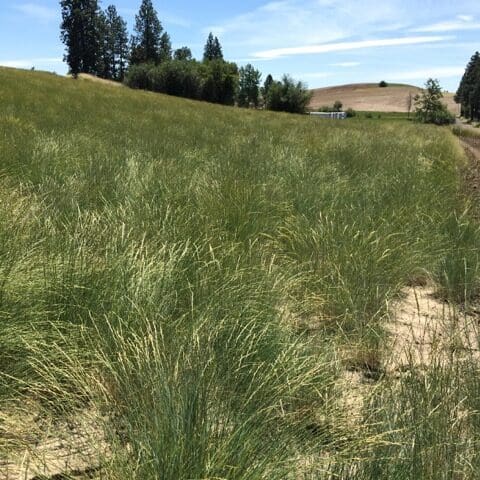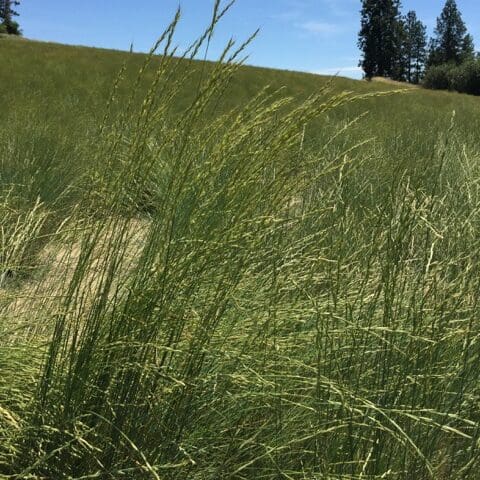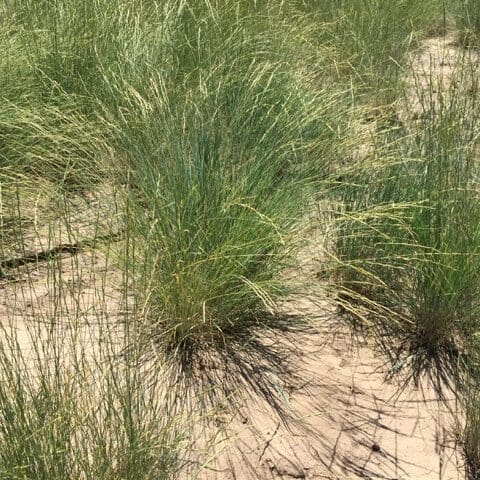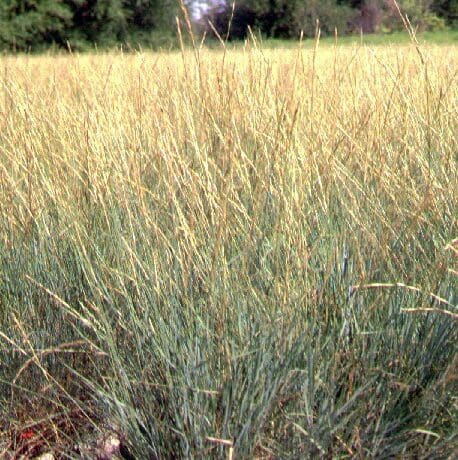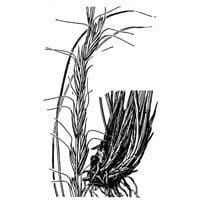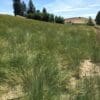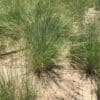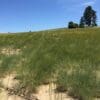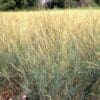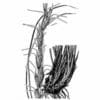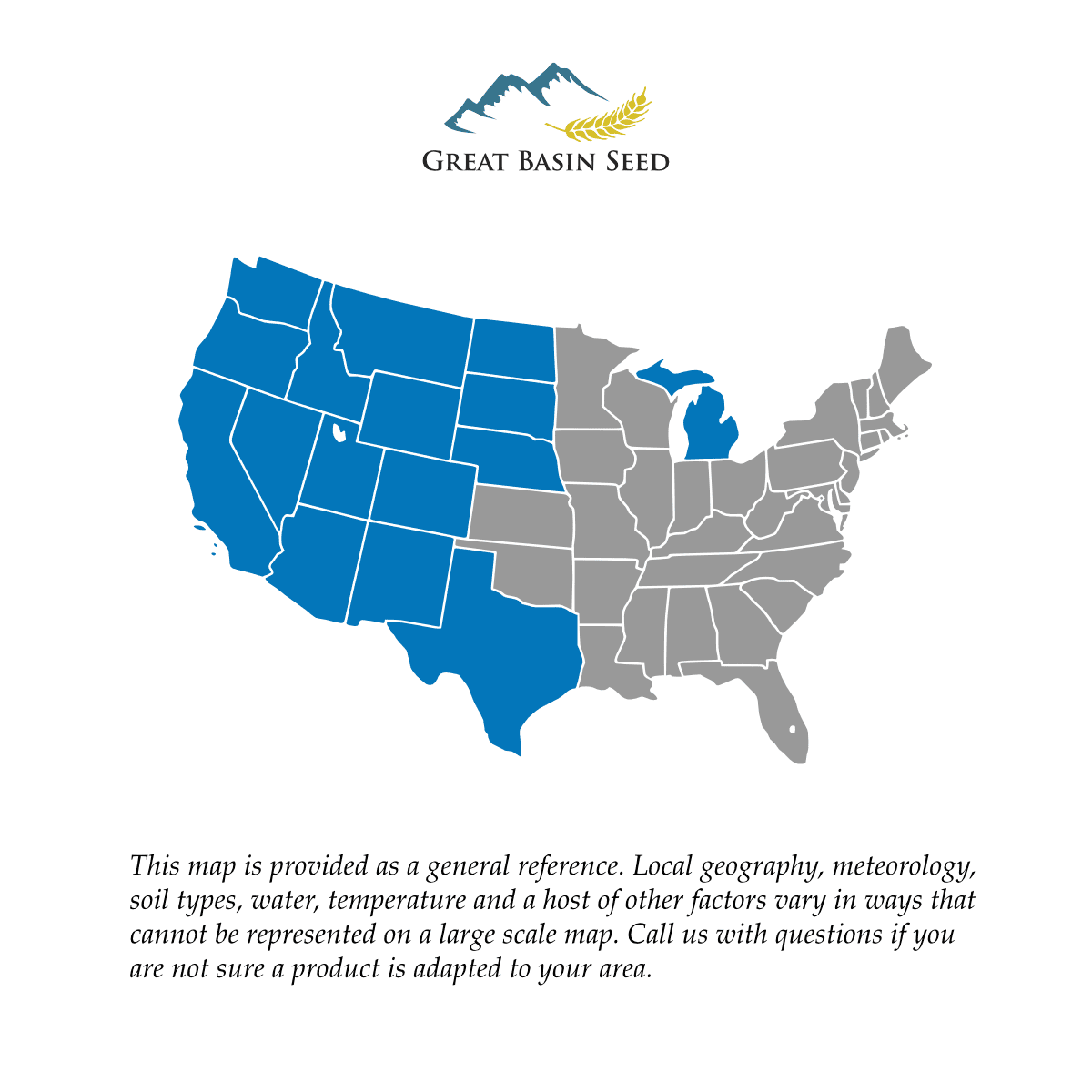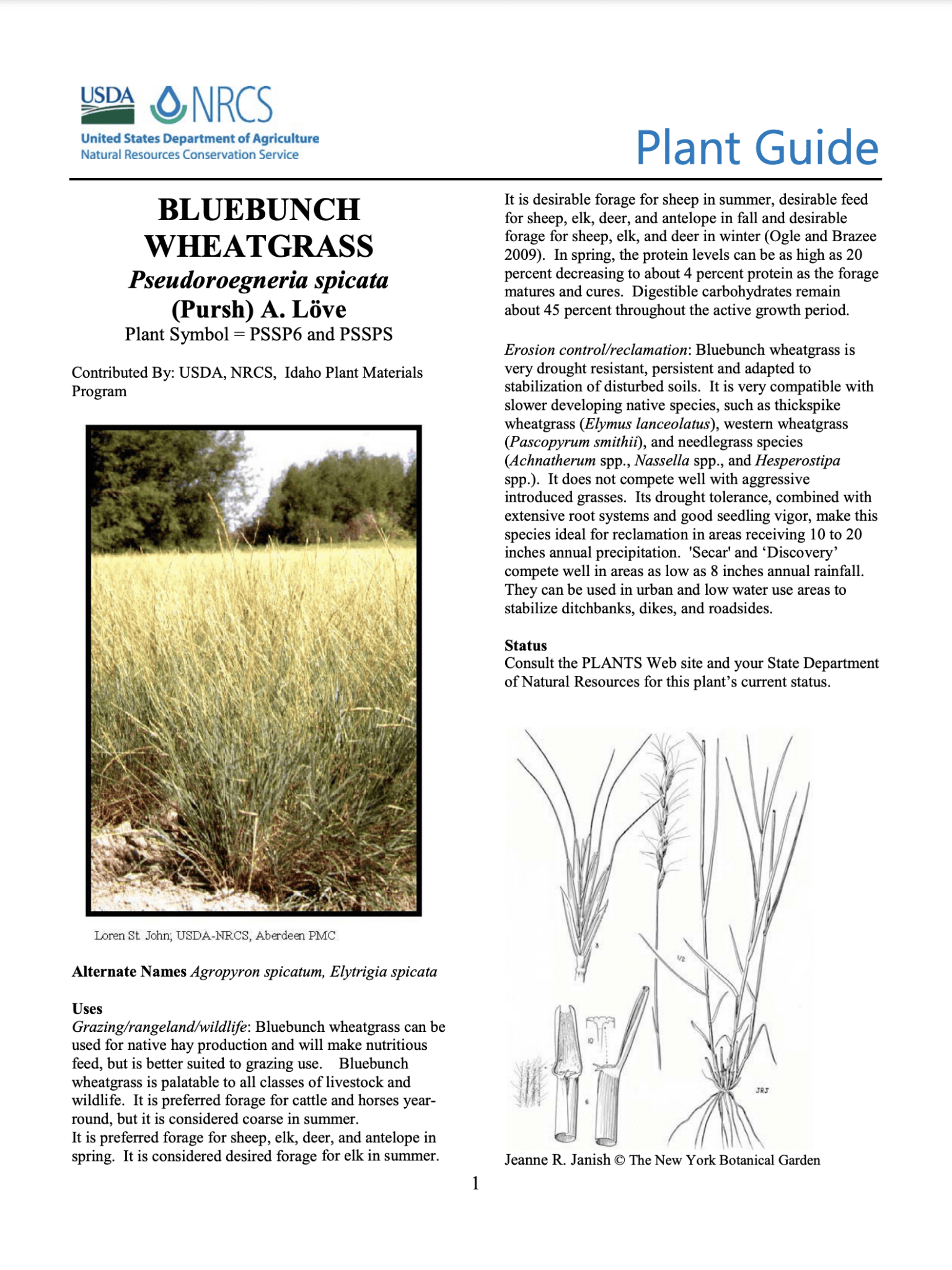Bluebunch Wheatgrass
- Scientific Name: Pseudoroegneria spicata
- Long-lived cool season perennial
- Extremely palatable
- Adapted to less productive soil and drought
- A slower developing native grasses
- Does not compete with aggressive introduced species
Min. to Max. Annual Precipitation
48in.
Average Max. Height
Bluebunch Wheatgrass is a long-lived perennial, cool season native bunchgrass. Extremely palatable to all classes of livestock and wildlife, and adapted to less productive soil and drought. It is cold tolerant, moderately shade tolerant, and highly fire tolerant.
Bluebunch Wheatgrass (Pseudoroegneria spicata) is a vital native species in the West. It is extremely palatable and adapted to less productive soil and drought. It is a long-lived perennial, cool season native bunchgrass that grows up to 4 feet tall. It has an extensive root system with strong tillers. Bluebunch wheatgrass spreads by seed but in high rainfall zones it may spread by short rhizomes. It is native to the Intermountain West and has no known negative impacts on wild or domestic animals. It is not considered a weedy or invasive species but can spread to adjoining vegetative communities under ideal environmental conditions.
Bluebunch wheatgrass (Pseudoroegneria spicata) is most abundant in 10 to 20 inch annual precipitation areas in sagebrush and juniper communities. Its elevation range is from 500′ to 10,000′. It is a major component of many native plant communities and generally occupies 20 to 60 percent of the overall composition by weight. Bluebunch wheatgrass is common to the northern Great Plains, Northern Rocky Mountains and the Intermountain regions of the western United States. It does best on medium to coarse textured soils, but can be found on a range of soil textures over 10 inches deep. It will tolerate weakly saline conditions but does not grow on highly acidic sites. It is cold tolerant, moderately shade tolerant, and highly fire tolerant. It is not tolerant of high water tables, poor drainage, or periods of extended inundation.
Bluebunch is very drought resistant, persistent and adapted to stabilization of disturbed soils. It is very compatible with slower developing native grasses, but does not compete well with aggressive introduced species. Its drought tolerance, combined with extensive root systems and good seedling vigor, make this species ideal for reclamation in areas receiving 10 to 20 inches annual precipitation. It can be used for native hay production and will make nutritious feed, but is better suited to grazing use. Bluebunch wheatgrass is palatable to all classes of livestock and wildlife.
Bluebunch Wheatgrass Cultivars:
‘Anatone’ Selected Class Germplasm originated near Anatone, Washington. It was released by the Forest Service, BLM, Aberdeen PMC, Idaho-Utah AES, ARS and the Utah Division of Wildlife Resources in 2003. Anatone establishes rapidly and can survive under dry conditions at or above 10 inches rainfall. It is intended for use on rangelands for re-establishment of native plantcommunities, vegetative firebreaks, and critical area stabilization. Certified seed is available.
‘Goldar’ was selected from seed collected on Mallery Ridge in Asotin County, Washington. It was released by Idaho-Utah AES, ARS and the Aberdeen PMC in 1989. Goldar is noted for rapid establishment, high forage production, and the ability to survive with 12 inches precipitation.
Synonyms: Agropyron spicatum, Agropyron spicatum, Elytrigia spicata
***click the “Quick Plant Facts” tab above for more information***
Bluebunch Wheatgrass NRCS Plant Guide
Bluebunch Wheatgrass NRCS Plant Guide
PDF version of NRCS Plant Guide & Fact Sheet
Citation: Ogle, D.G., L. St John and T.A. Jones. 2010. USDA Natural Resources Conservation Service. Idaho and Washington Plant Materials Program.
Bluebunch Wheatgrass USDA NRCS Fact Sheet
Bluebunch Wheatgrass USDA NRCS Fact Sheet
PDF version of NRCS Plant Guide & Fact Sheet
Prepared By: Derek Tilley; USDA NRCS Plant Materials Center, Aberdeen, Idaho.
Loren St. John, USDA NRCS Plant Materials Center, Aberdeen, Idaho.
Bluebunch Wheatgrass USDA NRCS Plant Guide
Bluebunch Wheatgrass USDA NRCS Plant Guide
PDF version of NRCS Plant Guide & Fact Sheet
Prepared By: Daniel G. Ogle USDA, NRCS, Boise, Idaho
Loren St. John USDA, NRCS, PMC, Aberdeen, Idaho
Dr. Thomas A. Jones USDA, ARS, Forage and Range
Laboratory, Logan, Utah
Helpful Links
Additional information about this product can be found on the academic websites linked below.
Synonyms
Many plants have more than one common and scientific name. We've listed a few of them below.
- Bluebunch Wheatgrass
- Pseudoroegneria spicata
- Elymus spicatus
- Agropyron spicatum
Who is Great Basin Seed?
Great Basin Seed is a seed company that specializes in seed sales and consultation for home, ranch, farm, range and reclamation. We have been a leader in the seed industry since 1974.
Our History
We've been in the seed business since 1974.
What We Offer
We offer seed for home, farm, ranch, range and reclamation projects.
Meet the Gang
We have the best employees in the world! We are proud of the work they do, and trust them to serve you!
Right: Company founder Lloyd and his wife Paula Stevens in a wildflower seed production field circa 1977
Quick Plant Facts
| Common Name: | Bluebunch Wheatgrass |
|---|---|
| Scientific Name: | |
| Old Scientific Name: | |
| Lifespan: | |
| Origin: | |
| Plant Type: | |
| pH Tolerance: | |
| Seed Count | 139,000 seeds/lb. |
| Growth Height: | |
| Root Form | Bunchgrass |
| Planting Rate: | |
| Min. Precipitation | 8-14 Inches Minimum |
| Best Time to Sow: | |
| Max Sowing Depth: | |
| Sun & Shade Tolerance: | Full sun, Partial shade |
| Growth Season: | |
| Plant PDF File | psspsp.pdf |
| Hardiness Zones: |
